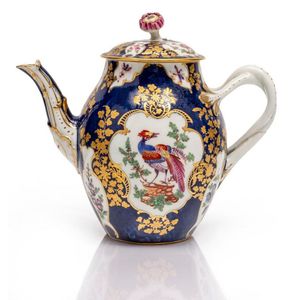Worcester Royal-Blue Teapot with Exotic Birds and Flowers
A rare and fine Worcester Royal-blue scale ground and gilt ovoid teapot and cover, painted in The Lady Mary Wortley Montagu Pattern?, version no. 7, in the London atelier of James Giles with exotic birds and flowers in reserved panels. English circa 1770, underglaze blue open crescent mark, double stem handle. Provenance: Albert Amor Ltd London 09/01/1996 (8750 pounds). Robert Burke collection no 129. Reference: Gerald Coke 'In Search of James Giles'. p.164. Anne George when writing to Robert Burke notes that this teapot is both rare and very fine and that the she could only find two recordings of the moulded spout. One on a pot in the Dyson Perrins Museum illus.Marshall pl.8. no.141. (but with different handle and cover) and in the same book a pot of identical shape pl.39. no 831. and she comments on the extraordinary bird in flight panel on the base of the spout. A related example with a different spout in this collection lot no 98, 17 cm high, 19.5 cm wide across the handle and spout, base diameter 6.5 cm
You must be a subscriber, and be logged in to view price and dealer details.
Subscribe Now to view actual auction price for this item
When you subscribe, you have the option of setting the currency in which to display prices to $Au, $US, $NZ or Stg.
This item has been sold, and the description, image and price are for reference purposes only.
- Circa - A Latin term meaning 'about', often used in the antique trade to give an approximate date for the piece, usually considered to be five years on either side of the circa year. Thus, circa 1900 means the piece was made about 1900, probably between 1895 and 1905. The expression is sometimes abbreviated to c.1900.
- Atelier - Atelier (French for "workshop"), in English usuage describes the workshop of an artist in the fine or decorative arts, where the artist and a number of assistants, students and apprentices worked together producing pieces that went out in the artists name. This was the standard practice for European artists from the Middle Ages to the 18th or 19th century
- Oviform /ovoid - The outline loosely resembling the shape of an egg.
This item has been included into following indexes:
